
R-Type is a horizontally scrolling shooter arcade video game developed and released by Irem in 1987 and the first game in the R-Type series. The player controls a star ship, the R-9 "Arrowhead", in its efforts to destroy the Bydo, a powerful alien race bent on wiping out all of mankind. The R-9 can acquire a glowing orbicular device called a "Force", protecting it from enemy fire and providing additional firepower. The arcade version was distributed by Nintendo in North America; it is the last arcade title Nintendo distributed.
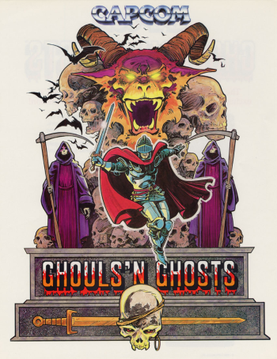
Ghouls 'n Ghosts, known as Dai Makaimura in Japan, is a side-scrolling platform game developed by Capcom, released as an arcade video game in 1988 and ported to home platforms. It is the sequel to Ghosts 'n Goblins and the second game in the Ghosts 'n Goblins series.

Wonder Boy in Monster Land, known by its original arcade release as Wonder Boy: Monster Land, is a platform video game developed by Westone Bit Entertainment and released by Sega in Japanese arcades in 1987 and for the Master System in 1988, with a number of other home computer and console ports following. The game is the sequel to the 1986 game Wonder Boy and takes place eleven years after the events in the previous game. After enjoying over a decade of peace on Wonder Land following the defeat of the evil King by Tom-Tom, later bestowed the title "Wonder Boy", a fire-breathing dragon called the MEKA dragon appeared; he and his minions conquered Wonder Land, turning it into "Monster Land". The people, helpless due to their lack of fighting skill, call for Wonder Boy, now a teenager, to destroy the monsters and defeat the MEKA dragon. Players control Wonder Boy through twelve linear levels as he makes his way through Monster Land to find and defeat the MEKA dragon. Players earn gold by defeating enemies and buy weapons, armor, footwear, magic, and other items to help along the way.

Chase H.Q. is a vehicular combat racing game, originally released as an arcade video game by Taito in 1988. It is sometimes seen as a spiritual successor to Taito's earlier Full Throttle. The player assumes the role of a police officer named Tony Gibson, member of the "Chase Special Investigation Department". Along with his partner, Raymond Broady, he must stop fleeing criminals in high-speed pursuits in a black Porsche 928.
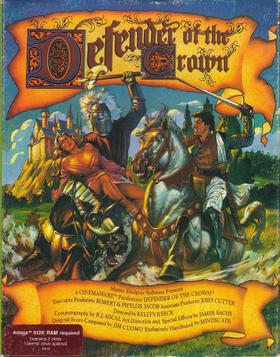
Defender of the Crown is a strategy video game designed by Kellyn Beeck. It was Cinemaware's first game, and was originally released for the Commodore Amiga in 1986, setting a new standard for graphic quality in home computer games.

Cinemaware was a video game developer and publisher. It had released several titles in the 1980s based on various film themes. The company was resurrected in 2000, before being acquired by eGames in 2005.

Wonder Boy III: The Dragon's Trap, known as Monster World II in Japan, is a platforming action-adventure video game developed by Westone as part of Sega's Wonder Boy series. It was published by Sega and released for the Master System in 1989 and for the Game Gear in 1992 as Wonder Boy: The Dragon's Trap. It was ported by Hudson Soft and released in 1991 for the TurboGrafx-16/PC Engine under the name Dragon's Curse. It was also ported in 1993 by Brazilian company Tec Toy under the title Turma da Mônica em o Resgate, with the game retooled to include characters from Brazilian comic book series Monica's Gang. A remake developed by Lizardcube and published by DotEmu, titled Wonder Boy: The Dragon's Trap, was released in April 2017.

Bonanza Bros. is a 3D-style, 2D side-scrolling stealth action game developed and released by Sega in 1990. It is one of the earliest arcade games powered by the Sega System 24 arcade system board. It was ported to various home systems, including the Mega Drive/Genesis, Master System, PC-Engine/TurboGrafx-CD, and several home computers.

Wings is a World War I video game developed and published by Cinemaware. It was released for the Amiga in 1990. The action sequences are similar in style to those of the 1927 silent film Wings.

Jungle Strike is a video game developed and published by Electronic Arts in 1993 for the Sega Genesis/Mega Drive. The game was later released on several other consoles such as the Super Nintendo Entertainment System (SNES), and an upgraded version was made for DOS computers. The Amiga conversion was the responsibility of Ocean Software while the SNES and PC DOS versions were that of Gremlin Interactive, and the portable console versions were of Black Pearl Software. It is the direct sequel to Desert Strike and is the second installment in the Strike series. The game is a helicopter-based shoot 'em up, mixing action and strategy. The plot concerns two villains intent on destroying Washington, D.C. The player must use the helicopter and occasionally other vehicles to thwart their plans.

PGA Tour Golf is a golf video game and the first in the PGA Tour game series. It was developed by Sterling Silver Software and released in 1990, for MS-DOS. It was initially published by Electronic Arts, which subsequently released versions of the game for Sega Genesis and Amiga in 1991, followed by a version for the SNES in 1992. By 1994, Tengen had published versions for Sega's Master System and Game Gear consoles. PGA Tour Golf received generally positive reviews for its realism, sound, and camera. Several critics considered the computer versions to be the best golf game available at the time of its release. It was followed by PGA Tour Golf II.
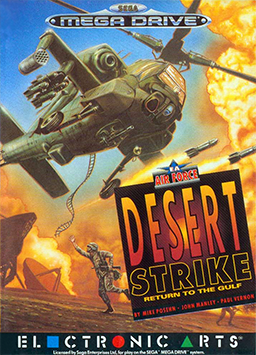
Desert Strike: Return to the Gulf is a shoot 'em up video game released by Electronic Arts (EA) in March 1992 for the Sega Genesis. The game was released on several other formats such as the Super Nintendo Entertainment System, including a much upgraded version for the Amiga home computer. The game was inspired by the Gulf War and depicts a conflict between an insane Middle Eastern dictator, General Kilbaba, and the United States. The player controls an Apache helicopter and attempts to destroy enemy weapons and installations, rescue hostages and capture enemy personnel, while managing supplies of fuel and ammunition.

Bloody Wolf, released in Europe as Battle Rangers, is a run and gun arcade game released by Data East in 1988. Two commandos take on an entire army with many weapons, and defeat bosses to advance levels.

Bomberman, also known as Dyna Blaster in Europe, is an action-maze video game originally developed and published by Hudson Soft for the PC Engine in Japan on 7 December 1990 and later in North America for the TurboGrafx-16 by NEC in 1991. Belonging to the Bomberman franchise, it is a re-imagining of the first game in the series starring White Bomberman on a quest to rescue Lisa, the kidnapped daughter of his inventor Dr. Mitsumori, from the castle of Black Bomberman while defeating evil monsters and villains that work for him. The game was later ported to home computers, each one featuring changes compared to the original version. Conversions for other platforms were in development but never released. The title garnered positive reception from critics since its initial release on the PC Engine/TurboGrafx-16 and later on home computers.
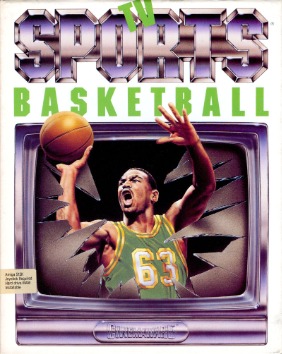
TV Sports: Basketball is a 1989 computer basketball game for the home computers. It was developed by Cinemaware and published by Mirrorsoft for the Amiga, MS-DOS, Commodore 64 and TurboGrafx-16. It is part of the TV Sports series that included TV Sports: Baseball as well as other games based on hockey and American football.

Falcon is a combat flight simulator video game and the first official entry in the Falcon series of the F-16 jet fighter's simulators by Spectrum HoloByte. Originally developed by Sphere for Macintosh and MS-DOS in 1987 and ported to several platforms between 1988 and 1992, the game earned commercial success and critical acclaim.
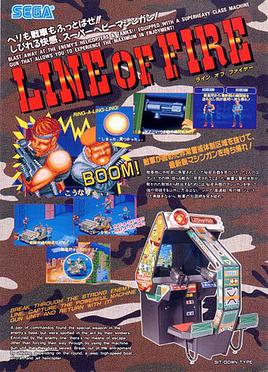
Line of Fire is a first-person light gun shooter game developed by Sega and released for arcades in 1989. It was released with two arcade cabinet versions, a standard upright and a sit-down cockpit, both featuring two positional guns. The cockpit design allows the player(s) to sit down while playing the game, while having two-handed machine guns, controlled by a potentiometer-controlled gun alignment software system. The game follows a two-man commando unit as they try to escape from a terrorist facility after seizing a prototype weapon.

Jack Nicklaus' Greatest 18 Holes of Major Championship Golf is a golf-simulation video game developed by Sculptured Software, and published by Accolade beginning in 1988. It was released for the Amiga, Amstrad CPC, Apple IIGS, Atari ST, Commodore 64 (C64), MS-DOS, Macintosh, MSX, Nintendo Entertainment System (NES), PC-88, Sharp X68000, and Game Boy.

TV Sports: Football is a 1988 video game by Cinemaware for Amiga, Atari ST, Commodore 64, DOS, and TurboGrafx-16.
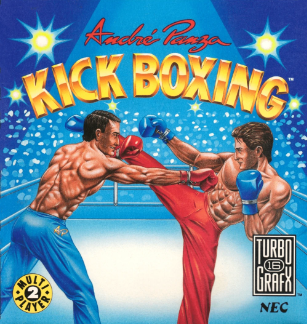
Panza Kick Boxing is a French fighting video game developed by Futura and originally published by Loriciels in 1991. The game is a video game adaptation of Thai kick boxing. It received high critical praise particularly for its graphics and gameplay while receiving minor criticism for its repetitiveness. A sequel with various names to distance from the Panza endorsement, including Best of the Best: Championship Karate in the United States, was released a few years later.





















